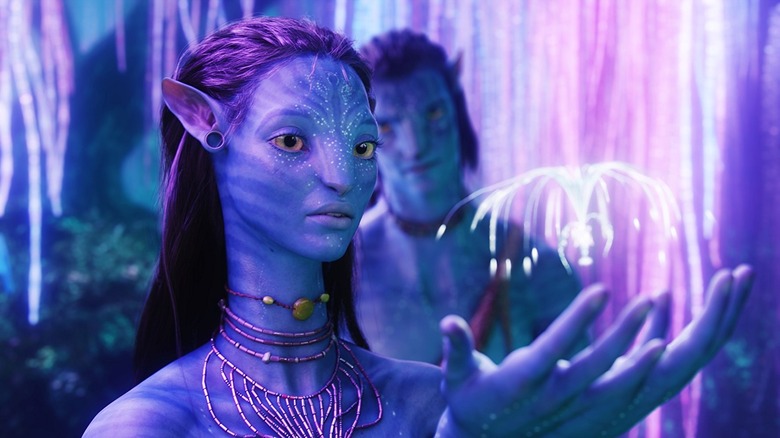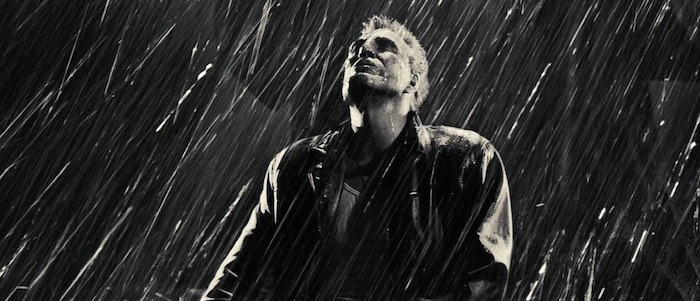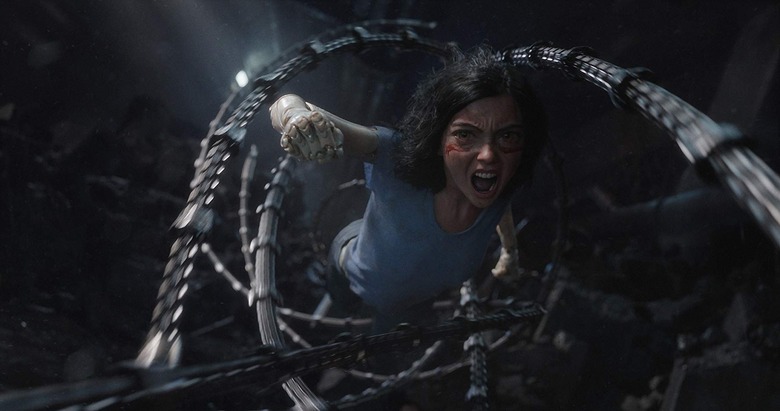Despite Its Faults, 'Alita: Battle Angel' Is The Kind Of Cinematic Spectacle We Rarely See These Days
Alita: Battle Angel is the latest action extravaganza from two of our most auteur-like blockbuster directors working: Robert Rodriguez and James Cameron. Cameron served as a producer, but has spent over a decade trying to get the film off the ground on his own. It was originally announced in 2003 but production of Avatar kept Cameron from committing to the project, in addition to other development issues. In 2016, Robert Rodriguez was brought on as a director and the film finally got made.Based on a '90s manga series by Yukito Kishiro called Gunnm in Japan and Battle Angel Alita here in the US, the theatrical Alita: Battle Angel is a marvel of technology, offering rich visuals and kinetic action that is beyond fun to watch.I think the merit in this film isn't necessarily with the story and script, which is serviceable, if not bloated. And it only feels bloated in order to tee up a sequel I wonder if we'll ever get. No, the merit in this film is spectacle.Spectacle has drawn people to the movies since the very first days of cinema. Even Fred Ott's Sneeze was the height of spectacle when people first saw it, but silent film evolved and it came to be known for the work of George Melies and Fritz Lang and Cecil B. Demille. Audiences have always been drawn to technological advances. The Jazz Singer was a (racist) hit for the novelty of audio. The Wizard of Oz and Gone With the Wind still hold box office records in no small part because they broke the mold of black and white film first. This continued apace. Animated films. 3D. Technicolor. Vista-vision. When the technology of presentation was settled, special effects were the next frontier and films like Star Wars (1977) showed audiences something they'd never seen before. This has been the golden ticket filmmakers chased ever since the realm of spectacle. What could filmmakers do to push the envelope?Over the years, that answer became computer graphics and it seemed to culminate in Steven Spielberg's Jurassic Park. But that was still just a baby step. Audiences just didn't know it yet. Star Wars: Episode I – The Phantom Menace propelled things into the future with fully realized, photo-realistic characters generated in the computer interacting seamlessly with live-action elements, compliments of Industrial Light & Magic. WETA Workshop took that work a step further with the motion capture performances in The Lord of the Rings trilogy and filmmakers soon realized that the limits of filmmaking were no longer constrained by technology, but by their imagination.
Avatar
Though technology has made advances over the last 20 years since those watershed moments, it's been less drastic leaps and more like smaller steps of iteration. Once in a while, something will take your breath away. James Cameron's Avatar did that in the world of 3D filmmaking. To my mind, it was the spectacle of Avatar and the new technology that propelled it to success rather than the story in the film itself. For the first time, the 3D effects we'd been promised with the new technology were real and vivid. Cameron's technological acumen paid off in spades, creating one of the most successful films in the history of the media. I would argue that since the film has failed to leave virtually any cultural footprint since its release, it was the spectacle of the technology that brought audiences to the theater and not, in any way, the story.This is why that you'd be hard-pressed to find anyone who knows the names of the characters in Avatar or any of the stories of the mythology. For a year or two, there were the occasional Na'vi cosplayers at conventions, but even that has all but disappeared. Even the recent Pandora expansion at Disney World's Animal Kingdom park seems more driven by the spectacle of the ride experience than fans of Avatar flocking to the park en masse they way they're expected to with the upcoming Star Wars additions.James Cameron has made so few movies over the last three decades, it seems, because he almost seems more interested in the technology than the films themselves. Alita: Battle Angel seems no exception. And since he's busy making sequels to Avatar, he needed someone else with the chops to push the envelope for him. That's where Robert Rodriguez entered the picture.
Spy Kids and Sin City
Robert Rodriguez got his start making El Mariachi for pennies on the dollar, a brilliant, Spanish-language action film that premiered out of the Sundance Film Festival. Over the years, he was able to buy his autonomy from Hollywood and set up his own operation in Austin, Texas. That's where he shot films like Spy Kids and Sin City and these, I think, are what gave him the chops to pull off Alita: Battle Angel.In fact, there's a direct line between the effects of Star Wars and Spy Kids. Spy Kids, which came out in 2001, was the last Rodriguez picture shot on actual film. He did his post-production work at Skywalker Ranch and that's where George Lucas was working on Attack of the Clones, the first major feature film shot entirely with digital cameras. Rodriguez built on his repertoire by shooting Spy Kids 2 digitally. It became only the second film (of two) in 2002 to be shot and released digitally. The first was Lucas' Attack of the Clones.Rodriguez used the digital work flow to push the medium even further, creating an accurate, stark black, white, and yellow world for the adaptation of Frank Miller's Sin City, which was released in 2005. Shooting almost entirely in front of a green screen, Rodriguez was able to capture the imagination of comic book and noir fans by forcing the technology one step further. I believe Sin City was a success because of the nature of spectacle. It brought home more than $150 million worldwide. I also believe the spectacle had worn off by the time the 2014 sequel, Sin City: A Dame to Kill For, was released. It made less than a third of that. Audiences had seen it before and Miller's stories feel as though they grow more stale and problematic as days go by.Cameron chose Rodriguez to bring that pioneering spirit to Alita: Battle Angel, but also because of the range of Rodriguez's abilities as an action filmmaker. According to Cameron, "[Robert Rodriguez] likes to make kids' movies but he also likes to make the opposite end of the spectrum. Very rough, hard-edged, grown-up kind of action films. So Alita's kind of right in the middle. It's got its tough moments, it's got it's hard-edged action, but it's also got this soft kind of wondrous center to it."
Alita
As a film, Alita: Battle Angel is gorgeous to look at. The sweep of the city evokes images of everything from Blade Runner and Mad Max to Star Wars and Rollerball, but, at its core, is a faithful—possibly too faithful—adaptation of the classic Japanese story. It provides a number of thrilling sequences that show off both the technological advances of the media and Rodriguez's chops as an undisputed master of the action sequence.The script, written by James Cameron and Laeta Kalogridis, is where the film falters. Instead of telling a neat, compact story that introduces you to the world and the central conflict, it works too hard to include all the material needed for a sequel. This really bloats a film that would otherwise have been streamlined down to only its most essential elements and conflicts. It also removes a lot of the mystery of Alita herself, giving us answers about who she is and where she came from a little too quickly, if we even needed them at all. It all serves to defocus the story in favor of franchise storytelling, but is this even going to be a franchise? I wonder. I hope so, this was a fun ride. But I don't see it as likely. But I never saw Avatar as a franchise, either, so maybe there's hope.There is plenty of solid filmmaking on display, though. For audiences unfamiliar with the story, Rodriguez is able to pull masterful bits of Hitchcockian misdirection reminiscent of Rear Window and Suspicion. In fact, the threat of Dr. Ido (played with warmth and charm by Christoph Waltz) being a killer is deftly assembled, forcing the audiences to participate in the suspense of the film.Rodriguez handles the quiet moments with aplomb, the action sequences like a genius, and the cheese of the story with a warm embrace. You'll definitely have to suspend your disbelief for the film to work, but that's easy when it's so fun to look at. The romance in Alita: Battle Angel is just as authentic if not cheesy; Rodriguez directs with his heart on his sleeve and it fits neatly into the B-movie vibe that pervades the film.The reason people should be talking about it, though, the spectacle that would bring them to the theatre, should be Alita herself. Played by Rosa Salazar, Alita is the beating heart of the film, both from a story standpoint and a technological one. Alita is a photo-realistic motion-capture creation that interacts and emotes flawlessly as a near-human cyborg. This is the sort of technology that brought Grand Moff Tarkin to life in Rogue One, which made that film, in my view, the most George Lucas-y of the recent batch of Star Wars films—taking bold steps into the world of effects without concern. Tarkin ran into problems because he was an iconic character played in life by an iconic actor. Everyone knew what he was supposed to look and sound like. This is not a problem with Alita, though some have expressed an inability to get over the exaggerated eyes of the character. They say the eyes are the windows to the soul, and the team at WETA who brought Alita to life, in tandem with Salazar, created an authentic one and they should be proud of the work they've done.But will that be enough to bring audiences to the theatre? The weekend box office returns suggest no. Is this enough of a step forward in the technology that audiences will want to see it in and of itself? If they go to the theater, will they believe Alita and enjoy the action sequences and thrill ride the movie brings one on? Or will they stay at home because it looks like the sort of thing they've seen before?I hope audiences do give this film a shot. For all the faults of the script, there's a lot to love in the movie. It might be the most original film on the slate of comic book movies to hit in 2019, it would be a shame if people didn't give it a shot.



